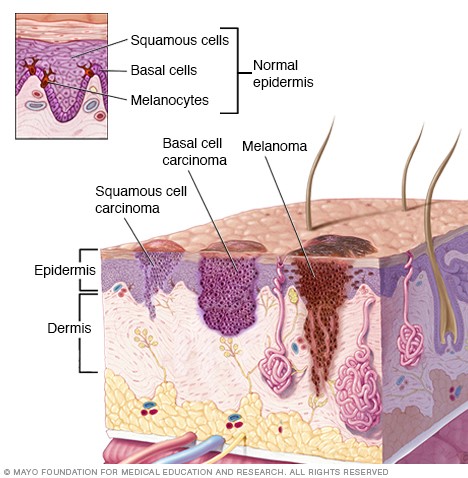What is Skin Cancer?
Globally, skin cancer is one of the most common forms of cancer. Skin cancer occurs as a result of an abnormal growth of skin cells. Skin cancer often develops on skin exposed to the sun (ultraviolet or UV radiation). The cell types involved in the major forms of skin cancer are squamous cells, basal cells and melanocytes. These are all situated in the epidermis (outer layer) of the skin (see image below). Other less common skin cancers are Kaposi sarcoma, Merkel cell carcinoma and Sebaceous gland carcinoma (1).

A schematic picture illustrating the skin and the different skin cells (1)
© Mayo Foundation for Medical Education and Research. All rights reserved
What is Melanoma?
Melanoma is a cancer that begins in skin cells called melanocytes. Most melanoma cells produce melanin, thus melanoma tumours are usually brown or black. Some melanomas, however, do not produce melanin and can appear as pink, tan, or even white spots on the skin (2).
Melanomas can develop anywhere on the skin, but are more likely to occur on the trunk (chest and back) of men and on the legs of women. The neck and face are other common sites. People with darkly-pigmented skin usually have a lower risk of melanoma at these more common sites, however, practically everyone has the same chances of melanoma occurring on the palms of the hands, soles of the feet, and under the nails. Melanoma can also form in other regions of the body such as the eyes, mouth, genitals, and anal area, although these are much less common than melanoma of the skin.
Melanoma is an aggressive type of skin cancer. To reduce the risk of melanoma spreading to nearby tissues and other regions of the body, it is important that the cancer is diagnosed at an early stage. Although only 2 percent of all skin cancers are melanoma, this form still causes the most deaths (3).
Diagnosis
The first and most important warning signs of melanoma are a new spot appearing on the skin or a pre-existing spot that has changed in size, shape, or colour. A melanoma often has variations in colour and an irregular border. Both these indications are warning signs. Another important sign is a spot that looks different from all other spots on the skin. Melanoma can develop anywhere on the body, on otherwise normal skin or in an existing mole that transforms and becomes cancerous.
Preferably check your own skin once a month. Friends and family members can also assist with these examinations. In particular, those difficult-to-see areas such as the scalp and back. If you have any of the warning signs mentioned above, have your skin checked by a doctor. The earlier skin cancer is detected, the greater the chance of successful treatment.
The ABCDE rule is another commonly-used guide to assess the signs of melanoma. Be vigilant and tell your doctor about spots that have any of the following features:

A-Asymmetry: One half of a mole or birthmark does not match the other
B-Border: The edges are irregular, ragged, notched or blurred
C-Colour: The colour is not uniform and may include different shades of brown or black, or sometimes includes patches of pink, red, white or blue
D-Diameter: The spot is larger than 6 mm across, although melanomas can sometimes be smaller than this
E-Evolving: The size, shape or colour of the mole is changing with time
___
REFERENCES
(1) https://www.mayoclinic.org/diseases-conditions/skin-cancer/symptoms-causes/syc-20377605
(2) https://commons.wikimedia.org/wiki/File:Layers_of_the_skin.jpg
(3) https://www.cancer.gov/types/skin
READ MORE
https://www.cancer.org/cancer/melanoma-skin-cancer/detection-diagnosis-staging.html
https://www.cancer.gov/types/skin
https://www.cancer.org/cancer/melanoma-skin-cancer/detection-diagnosis-staging.html
https://www.yervoy.com/metastatic/what-is-metastatic-melanoma
http://www.mayoclinic.org/diseases-conditions/skin-cancer/basics/causes/con-20031606
http://www.mayoclinic.org/diseases-conditions/skin-cancer/basics/risk-factors/con-20031606
http://www.cancer.org/cancer/skincancer/index
http://www.cancer.gov/cancertopics/types/skin
http://www.cancer.org/cancer/skincancer-basalandsquamouscell/detailedguide/skin-cancer-basal-and-squamous-cell-what-is-basal-and-squamous-cell
https://www.cancer.org/cancer/melanoma-skin-cancer/detection-diagnosis-staging.html
https://www.health.harvard.edu/cancer/melanoma-overview
http://www.trcc.org/for-patients/patient-and-cancer-information/other/summary
http://www.cancer.gov/cancertopics/types/skin
https://www.cancerfonden.se/om-cancer/hudcancer
https://www.nccn.org/patients/guidelines/melanoma/files/assets/common/downloads/files/melanoma.pdf
